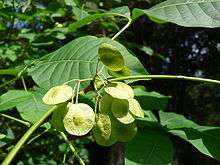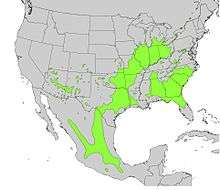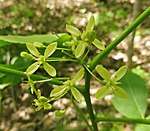Ptelea trifoliata
| Ptelea trifoliata | |
|---|---|
 | |
| Common hoptree fruit | |
| Scientific classification | |
| Kingdom: | Plantae |
| (unranked): | Angiosperms |
| (unranked): | Eudicots |
| (unranked): | Rosids |
| Order: | Sapindales |
| Family: | Rutaceae |
| Genus: | Ptelea |
| Species: | P. trifoliata |
| Binomial name | |
| Ptelea trifoliata | |
 | |
| Generalized natural range | |
| Synonyms[2] | |
| |
Ptelea trifoliata, commonly called the common hoptree[3] or wafer ash,[4] is a species of flowering plant in the citrus family (Rutaceae). It is native to North America, where it is found in Canada, Mexico, and the United States. It is a deciduous shrub or tree,[5][6] with alternate, trifoliolate leaves.
Description
Ptelea trifoliata is a small tree, or often a shrub of a few spreading stems, growing to around 6–8 m (20–26 ft) tall with a broad crown.[7]. The bark is reddish brown to gray brown, with short horizontal lenticels (warty corky ridges), becoming slightly scaly, The plant has an unpleasant odor and bitter taste. Branchlets are dark reddish brown, shining, covered with small excrescences. The twigs are slender to moderately stout, brown with deep U-shaped leaf scars, and with short, light brown, fuzzy buds. It has thick fleshy roots.[8]
Leaves
Its leaves are alternate, compound, tripartite, and dotted with oil glands. The leaflets are sessile, ovate or oblong, 3–5 in (7.6–12.7 cm) long by 2–3 in (5.1–7.6 cm) broad, pointed at the base, entire or serrate, and gradially pointed at the apex. They are feather-veined, with midrib and primary veins prominent. They come out of the bud conduplicate and very downy. When fully grown the leaves are dark green, shiny above and paler green beneath. In autumn they turn a rusty yellow. The petioles are stout, 2 ½ to 3 inches long, with an enlarged base. Stipules are absent. The western and southwestern forms have smaller leaves (5–11 cm) than the eastern forms (10–18 cm), an adaptation to the drier climates there.
Flowers
The flowers are small, 1–2 cm across, with 4–5 narrow, greenish white petals. The pedicels are downy. The 4- or 5-part calyx is downy and imbricate in bud. The corolla has four or five petals which are white, downy, spreading, hypogynous, and imbricate in bud. The five stamens alternate with the petals. The pistillate flowers bear rudimentary anthers. The filaments are awl-shaped and more-or-less hairy. The anthers are ovate or cordate, two-celled, with cells opening longitudinally. The ovaries are superior, hairy, abortive in the staminate flowers, two to three-celled. The style is short, the stigma 2- or 3-lobed, with two ovules per cell. Fertile and sterile flowers are produced together in terminal, spreading, compound cymes - the sterile being usually fewer, and falling after the anther cells mature.[8]
Flowers are produced in May and June. Some find the odor unpleasant but to others the plant has a delicious scent.
Fruit
The fruit is a round wafer-like papery samara, 2–2.5 cm across, light brown, and two-seeded. The fruit ripens in October, and is held on tree until high winds during early winter.[8]
Wood
Its wood is yellow brown; heavy, hard, close-grained, satiny. Sp. gr., 0.8319; weight of cu. ft., 51.84 lbs.[8]
Gallery
 Flowers of Ptelea trifoliata
Flowers of Ptelea trifoliata- Multi-trunk tree form
Taxonomy
While Ptelea trifoliata is most often treated as a single species with subspecies and/or varieties in different distribution ranges, some botanists treat the various Hoptrees as a group of four or more closely related species:[9]
- Common or Eastern Hoptree P. trifoliata (L.) ssp. trifoliata (Benth.); (P. trifoliata, sensu stricto) – eastern Canada & U.S., central U.S.[5]
- Common Hoptree P. trifoliata ssp. trifoliata var. mollis (Torr. & A. Gray) [9]
- Narrowleaf Hoptree P. trifoliata ssp. angustifolia (Benth.) (V. Bailey) var. angustifolia (Benth.) (M.E. Jones) (P. angustifolia, P. lutescens)
- Pallid Hoptree P. trifoliata (L.) ssp. polyadenia (Greene) – south-central and southwest U.S.[5][9]
- Pallid Hoptree P. trifoliata (L.) ssp. pallida (Greene) – southwest U.S.[5][9]
- Florida Hoptree P. trifoliata var. baldwinii (P. baldwinii)
The specific epithet "trifoliata" refers to the three-parted compound leaf.[8]
Distribution and habitat
Ptelea trifoliata is native to North America, where its northern limits are in Ontario and Quebec, Canada. It is native through much of the eastern and southwestern United States, although it is absent from some areas of the Upper Midwest and is rare in much of New England.[10] Its southern limits are in Mexico.[11][12]
It has a wide-ranging natural habitat. In the Southeastern United States it is most often found in rocky forests, in both moist and dry soil, often associated with calcareous or mafic substrates.[13] In the Midwest, habitats include forests, savannas, prairies, glades, and sand dunes.[14][15] In Arizona it is common in canyons.[16]
Cultivation
Numerous cultivars have been developed for ornamental use in parks and gardens. The cultivar 'Aurea' with golden leaves has gained the Royal Horticultural Society's Award of Garden Merit.[17][18]
Uses
German immigrants to Texas in the 19th century used its seeds in place of hops in the beer-making process. "Early settlers, desperate for a drink, substituted the fruits for true hops in beer-making, giving rise to the current common name."[19]
It has several Native American uses as a seasoning and as an herbal medicine for different ailments.[20]
References
| Wikimedia Commons has media related to Ptelea trifoliata. |
- ↑ "Ptelea trifoliata". Germplasm Resources Information Network (GRIN). Agricultural Research Service (ARS), United States Department of Agriculture (USDA). Retrieved 2009-12-01.
- ↑ The Plant List: A Working List of All Plant Species, retrieved 16 October 2015
- ↑ "Ptelea trifoliata". Natural Resources Conservation Service PLANTS Database. USDA. Retrieved 15 October 2015.
- ↑ Ptelea trifoliata Lady Bird Johnson Wildflower Center
- 1 2 3 4 5 USDA – Ptelea trifoliata (common hoptree) . accessed 8.24.2011
- ↑ ITIS Standard Report Page: Ptelea trifoliata . accessed 8.24.2011
- ↑ RHS A-Z encyclopedia of garden plants. United Kingdom: Dorling Kindersley. 2008. p. 1136. ISBN 1405332964.
- 1 2 3 4 5 Keeler, Harriet L. (1900). Our Native Trees and How to Identify Them. New York: Charles Scriber's Sons. pp. 32–35.
- 1 2 3 4 5 USDA PLANTS: P. trifoliata Classification . accessed 8.24.2011
- ↑ "Ptelea trifoliata". County-level distribution map from the North American Plant Atlas (NAPA). Biota of North America Program (BONAP). 2014. Retrieved 21 August 2018.
- ↑ Lady Bird Johnson Center @ wildflower.org . accessed 8.24.2011
- ↑
- ↑ Alan Weakley (2015). "Flora of the Southern and Mid-Atlantic States".
- ↑ [http://www.illinoiswildflowers.info/trees/plants/wafer_ash.htm Wafer Ash Ptelea trifoliata] IllinoisWildflowers
- ↑ Yatskievych, George (2013). Flora of Missouri, Volume 3. Missouri Botanical Garden Press. p. 1049.
- ↑ Ptelea trifoliata Southwest Desert Flora
- ↑ "RHS Plant Selector – Ptelea trifoliata 'Aurea'". Retrieved 27 June 2013.
- ↑ "AGM Plants - Ornamental" (PDF). Royal Horticultural Society. July 2017. p. 82. Retrieved 23 September 2018.
- ↑ "Texas Trees: A Friendly Guide". Retrieved 20 Jul 2015.
- ↑ University of Michigan – Dearborn: Native American Ethnobotany, species account. . accessed 8.24.2011